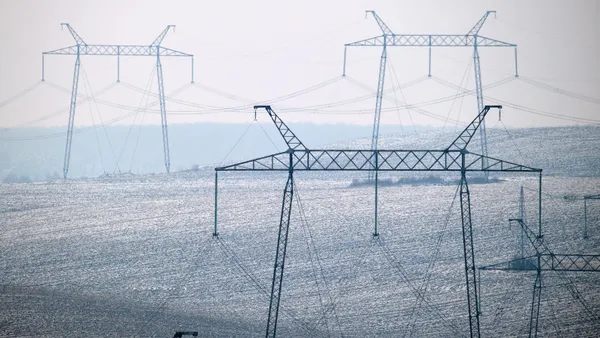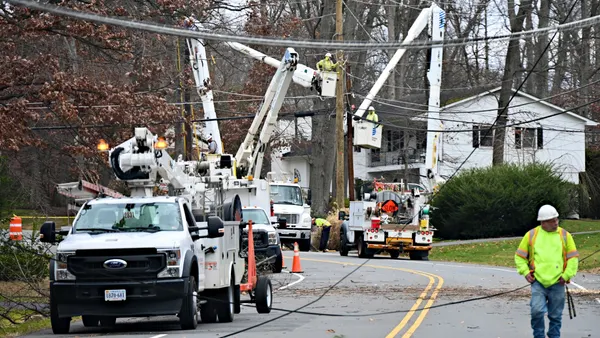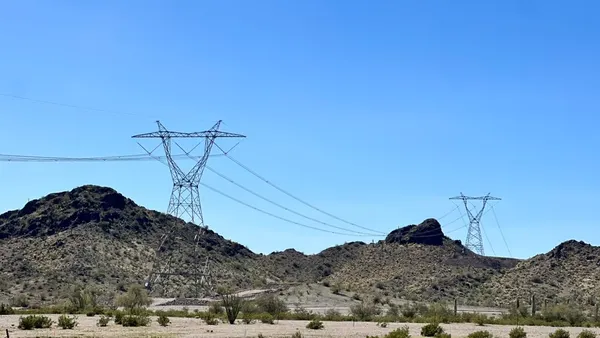Utilities have always tried to stay out of hot water with their customers. But now, they're itching to get into it.
A wave of interest is building in grid-integrated water heating (GIWH) as a path to system flexibility at a fraction of the cost of battery energy storage. At last count, 53.6 million of the 118.2 million U.S. water heaters were electric. Each could act as a battery for load shifting, peak shaving, or to integrate renewables, according to a Regulatory Assistance Project (RAP) paper.
Hot water is used largely by residential utility customers in morning and evening hours, wrote RAP Sr. Advisor Jim Lazar. But it can be heated “when power is most available.”
The stored hot water could then be used during the morning and evening without increasing system burden, Lazar wrote. And, to optimize the use of variable renewables, it could be heated at night to take advantage of high wind production and at midday to take advantage of abundant solar production.
Effective utility control of residential water heating could integrate “up to 100,000 MW of additional variable wind and solar energy in the U.S.,” Lazar wrote.
Transforming the U.S. electric water heater fleet to 100% GIWH represents a $3.6 billion per year market, according to think tank Rocky Mountain Institute (RMI). And “utilities, GIWH manufacturers, installers, solar companies, aggregators, and customers themselves can all capture a piece of this prize.”
Utilities across the country are catching on. There are GIWH pilots at Portland General Electric (PGE), Arizona Public Service (APS), and Green Mountain Power (GMP) in Vermont. PJM has introduced GIWH for frequency regulation and the California Energy Commission is discussing GIWH, according to Brattle Principal Ryan Hledik, co-author of a recent paper describing the GIWH opportunity
In the next 12 months to 18 months, Hledik said, it is likely there will be a utility-led “new wave of grid interactive water heating pilot programs.” The challenge, however, remains in spreading the benefits to all parties involved.
The market opportunity
Mark Dyson, RMI electricity markets division manager, agreed there is a new wave of interest in GIWH and added there is still ample room for growth. The $3.6 billion potential market is less than 1% of the U.S.’s $400 billion per year aggregate spending on electricity.
More significantly, between 40% and 60% of the electricity demand used for water heating can be shifted to create customer savings and grid services, he said. Grid services could include avoided generation capacity, avoided transmission and distribution capacity, energy arbitrage, and ancillary services in wholesale markets.
The right business model will be essential because there are significant hurdles, Dyson said. The first is getting the three dominant original equipment manufacturers (OEMs) involved. A.O. Smith, Bradford White, and Rheem own over 90% of the water heater manufacturing market and they are only beginning to see the GIWH value proposition, he said.
A.O. Smith Vice President Joshua Greene said his company has pilots in place with two electric cooperatives. It has also bid on programs from three large investor-owned utilities and is working on advanced technology trials.
“We are trying to figure out the value proposition and return on investment of a wide-scale deployment,” Greene said. But GIWH “is firmly on our radar and we anticipate being a leader in the space.”
Dyson said water heaters are a commodity business. “To reach scale, every water heater that comes off the assembly lines needs to have an inexpensive microchip that makes it grid interactive.”
The chip itself is no more than $5, but retooling an assembly line would add cost that could “bump manufacturers’ products off dealers’ trucks and cost market share,” he said.
More importantly, OEMs have no direct way to capture the value, Dyson said. The revenue goes to the water heater’s owner as bill savings, to the utility, or to an aggregator.
Smaller OEMs are going after the opportunity. Steffes’ Grid–Interactive Electric Thermal Storage (GETS) and Vaughn Thermal’s V-GRID ‘grid-enabled’ Electric Thermal Storage (ETS) technologies allow grid interactivity. In April, Steffes launched a 499-heater GETS program in Hawaii.
A.O. Smith’s Greene said his company sees customer adoption as the key hurdle. It will require marketing and working effectively with utilities and other market players. “Over time, as homeowners and small businesses become familiar with this technology, there will be an uptick in adoption.”
Eventually, “all water heaters will have some smarts,” Greene said. “They will either be connected to a utility grid or to a home energy management system.”
Dyson described two ways significant revenue could become available to OEMs.
One is through the outcome of an ongoing Federal Regulatory Commission proceeding to write rules for aggregated distributed resources in wholesale energy markets, he said. Those rules will allow aggregators to earn revenue in markets that serve 65% of U.S. electricity users.
“When manufacturers see demand from aggregators, they will start making water heating products to meet it,” Dyson said.
OEMs may be aggregators, he added. Mosaic Power’s Water Heater Efficiency Network (WHEN) manages nearly 7,000 GIWHs in PJM’s frequency regulation market. Its device attaches to customers’ water heaters and they share revenues generated when Mosaic controls water heating in a way that serves PJM without disrupting customers.
Shared revenue is the key to overcoming customer resistance, Dyson said. An aggregator with access to market earnings can resolve customer reluctance by providing a cost-free or discounted water heater and a share of the market returns. And the entire process can be completely automated.
Shared revenue can also make a grid-enabled water heater the least cost retail purchase option if the aggregator, distributor, or manufacturer subsidizes the purchase to capture the revenue opportunity, Dyson added. “That business model will get over the customer resistance barrier.”
Dyson believes wholesale markets are one of the two paths to a strong GIWH business case. “When the FERC ruling opens the market and aggregators find the right approach with customers, “this could move pretty quickly,” he said. “The other path is utility involvement.”
Utilities in the game
Green Mountain Power's recently-launched eSmartwater pilot program will provide up to 540 customers with an Aquanta water heater controller and a Nest Learning Thermostat. Customers will pay $0.99 per month to participate.
The Nest Learning Thermostat is expected to deliver the biggest value stream, said GMP Chief Innovations Executive Josh Castonguay. Efficiently controlling customers’ heating and air conditioning systems can reduce electricity bills by as much as $145 per year.
The Aquanta smart water heater controller will allow GMP to aggregate water heating for grid services. But the device overrides utility commands to protect customer access to hot water and further marginal customer savings are possible from its leak detector and shut off control.
Aquanta CEO Matt Carlson said the device is among the first of a new generation of GIWH controllers. “We are doing for the water heater what Nest and Lyric have done for the thermostat.”
Reducing total system energy consumption during peak periods with Aquanta's GIWH capabilities is important because GMP's rate with ISO-New England is based on peak usage, Castonguay said.
In addition, GMP incurs a peak usage transmission payment, Castonguay said. “By lowering both those costs, Aquanta lowers costs to all utility customers.”
GMP also expects GIWH to lower system costs during high solar production. The utility can use its knowledge of its system to heat water near where there are solar arrays, saving wear and tear on system wires, he said.
Using Aquanta’s capabilities to heat stored water to a slightly higher temperature “is a form of solar energy storage,” Castonguay added.
A third potential GIWH value is allowing the utility to do energy arbitrage in the ISO NE markets, Castonguay said. “We can heat water when the energy market has negative prices and when prices rise we can turn the water heaters off.”
GMP may also be able to aggregate water heaters and provide frequency regulation to ISO-NE when the program’s water heating capacity reaches a full megawatt, he added. “It requires a four second response but the Aquanta device is capable of that.”
Arizona Public Service
APS’s proposed GIWH pilot program is part of the utility’s effort to deal with its approximately 5% and rapidly rising distributed solar penetration, according to Kent Walter, manager of consumer technology and product development.
GIWH will allow the utility to “shift water heating from the morning peak into the midday solar production period, adding demand when the solar supply is high,” Walter said.
Participating customers will get a rebate for purchasing the water heater and an average bill saving of up to $40 per year. But, based on its survey of customer experience in other GIWH programs, APS anticipates that customers will not notice the utility’s management of their water heating, Walter said. “Other utilities call this ‘invisible load.’”
An Aquanta survey found only 3% of customers notice any impact, according to Carlson.
The APS program, which will involve 400 water heaters, will not be deployed until state regulators approve new time of use and demand charge rates in APS’s recent rate case settlement, Walter said. Approval of the utility’s proposed demand side management plan, of which GIWH is a part, will also be necessary.
“GIWH can work without the new rates if there are other incentives but the rates enable our customers to achieve savings by responding to the utility’s needs,” he said “The utility will also use its control of the water heaters to help customers avoid high demand charges.”
In Arizona, electric water heating is 17% of total electricity use, Walter said. He expects three system benefits from GIWH. The first is that shifting load to the solar production period will avoid overburdening feeders.
Moving the load to when solar production is high also allows more water heating to be done closer to the load. Walter, like GMP’s Castonguay, expects that to reduce wear and tear on system wires.
Finally, peak load reduction will reduce overall system cost by eliminating the need for new infrastructure like natural gas peaker plants or distribution system hardware, Walter said.
Portland General Electric
PGE Director of Retail Technology Strategy Conrad Eustis has been working on GIWH for ten years. The new generation of technology will allow PGE to move ahead with a 600-customer pilot program, he said.
An older generation of water heaters, with only off-on controls, allowed limited programs, he said. Smart power relays and communication interfaces, either built in or added on, make today’s electronic GIWH devices far more capable.
Only one of the big three OEMs is near the state of the art, he said.
“Bradford White is pretty much just getting into it and Rheem has an adaptor that works with home energy management systems," Eustis said. “But A.O. Smith has been very active.”
Bradford White and Rheem did not reply to offers to respond.
The one-year PGE GIWH pilot, which just began enrollment, will involve up to eight utilities in Washington and Oregon. It will incorporate both new and retrofitted water heaters from a range of OEMs and test year-round performance.
“The first goal is to quantify the actual overall kW load reduction,” Eustis said. “The second objective is to quantify the kWh reduction.”
PGE plans to create “a market transformation plan” based on the pilot's results, he added. That plan will make the business case for GIWH to utility leaders and policymakers.
The goal is for every water heater in the Pacific Northwest to be grid interactive-ready, Eustis said. “That greatly lowers the cost of using water heaters in demand response (DR) and for energy storage.” DR and storage can result in the very real benefit of helping utilities avoid the $1,000 per kW cost of a peaker plant, he said.
“Water heating is not exciting for most customers and they are even more uncomfortable with giving control to the utility,” Eustis said. “It is like recycling. We used to put trash in one can and now we have three or four cans and we sort. It is our civic duty.”













